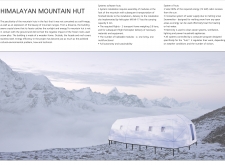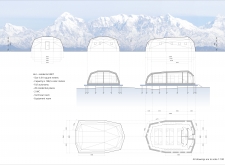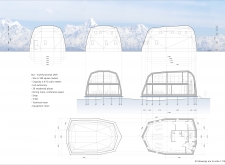5 key facts about this project
# Comprehensive Analytical Report on the Himalayan Mountain Hut
## Overview
Situated in the Himalayan region, the Mountain Hut serves as a practical shelter for trekkers navigating the challenging terrain. The design intends to harmonize with the natural landscape while effectively addressing the needs of hikers. By integrating modern technology within the context of traditional mountain architecture, the structure aims to enhance the user experience while maintaining a low environmental impact.
## Spatial Strategy
### Layout and Functionality
The Mountain Hut is organized into two distinct units. The Residential Unit spans 81 square meters and accommodates up to 20 individuals, featuring individual sleeping spaces for privacy. In contrast, the Multifunctional Unit covers 180 square meters and is designed to support a range of activities, including dining, retail, and group meetings. Essential amenities, such as restroom facilities and equipment storage, are also strategically incorporated to maximize space and functionality.
### Accessibility
A well-considered circulation plan facilitates smooth movement throughout the hut, enhancing accessibility for both transient visitors and those staying for extended periods. The design prioritizes adaptability, creating spaces that can easily transition between communal and private functions to meet the varying needs of users.
## Materiality and Sustainability
### Structural and External Materials
The Mountain Hut features a sturdy wooden frame, selected for its thermal efficiency and lightweight characteristics. The exterior is clad in stainless steel, providing durability against harsh weather while reflecting the surrounding landscape. This choice contributes to the structure’s visual integration within the environment.
### Energy Systems
To minimize its ecological footprint, the hut utilizes solar panels that generate approximately 12 kW of energy, fulfilling 90% of its energy needs. Additionally, an innovative snowmelter system captures and purifies melting snow to provide a reliable water supply, further enhancing its sustainability credentials. The use of prefabricated modules simplifies transportation and assembly, reinforcing the structure's adaptability and efficiency in remote locations.
Through these various elements, the Mountain Hut exemplifies a forward-thinking approach to architecture in extreme environments, balancing user needs with ecological responsibility.






















































